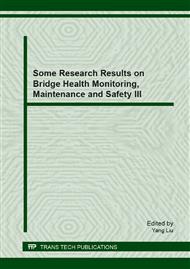p.1
p.11
p.21
p.31
p.43
p.53
p.67
p.77
Rapid Assessment Method of Girder Bridge Carrying Capacity Based on Traffic Running Test
Abstract:
The dynamic response under running vehicle of the bridge includes the static response. The frequency components of simple supported beam dynamic response under the uniform constant force and the harmonic force were discussed. A method using the low pass filter to extract the static displacement from dynamic response curves was proposed and extended to the continuous girder bridge. Simulation analysis describes the process of extracting static displacement. The results show that the method is effective to separate the static and dynamic compositions from the vibration deflection. The dynamic deflection curves of an actual bridge was studied to get the generalized influence lines and then vehicles were laid on them as the static load test program to estimate the static deflection. The results of research show the estimative deflection has high precision and meets the requirements of the bridge inspection. This method can replace the static load test for rapid assessment of the girder bridge.
Info:
Periodical:
Pages:
11-19
Citation:
Online since:
September 2013
Authors:
Price:
Сopyright:
© 2014 Trans Tech Publications Ltd. All Rights Reserved
Share:
Citation:


